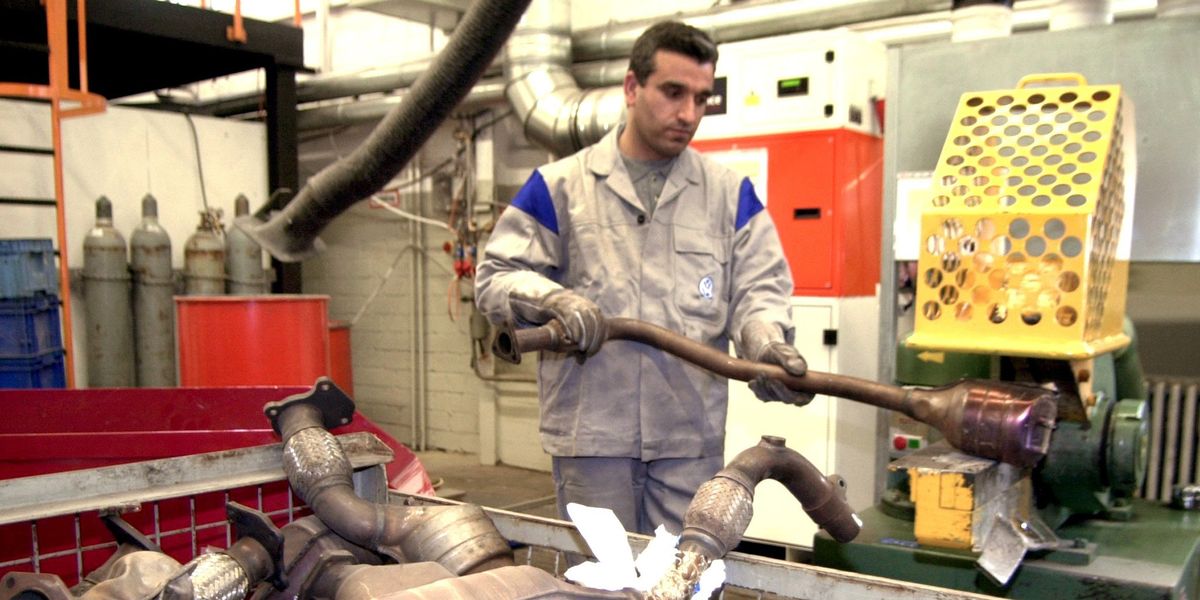Here's How Much Precious Metal Thieves Can Take from Your Catalytic Converter

Catalytic converter thefts have been on the rise over the last few years and show no signs of slowing down, as the prices of the precious metals that they contain continue to skyrocket. According to the National Insurance Crime Bureau, catalytic converter thefts saw an incredible 325 percent increase from 2019 to 2020. Much of it can be related to the state of global supply chains and the prices of the precious metals that allow a catalytic converter to function.
Catalytic converters are muffler-shaped devices that are part of the exhaust system that removes harmful pollutants from engine emissions. The inside of a catalytic converter contains a honeycomb structure that is coated with precious metals. Those precious metals act as a catalyst in order to break down those harmful pollutants and convert them into less harmful emissions. (Here’s a video showing how it all works.) Engines put out harmful gases such as hydrogen, carbon monoxide, and nitrogen oxide, and the catalyst process inside a catalytic converter converts these to less harmful substances such as water, carbon dioxide, and nitrogen.
Modern catalytic converters typically have two stages with the first stage being a reduction catalyst, which is there to eliminate nitrogen oxide, and the second stage being an oxidation catalyst, which eliminates carbon monoxide and unburned hydrocarbons. These stages are typically supported by cerium and ceramic honeycomb catalyst structures and coated with those pricey precious metals that thieves are after.
The three precious metals that are most commonly contained inside of a catalytic converter are platinum, rhodium, and palladium. All three have seen spikes in prices as the pandemic surged and as global supply chains slowed. According to kitco.com, the spot price of Rhodium went from $2,300 per ounce in January of 2019 to over $14,000 per ounce by December of 2020, so it’s not surprising that the NICB recorded thefts in the triple digits. The price increases of Rhodium didn’t stop in 2020 as it peaked at a price of $27,000 per ounce in April of 2021 and still remains well above those 2019 levels with a current price over $11,000 per ounce.
Platinum and palladium increases weren’t as drastic, but spot prices are still up over 2019 prices and the price of palladium roughly doubled from the beginning of 2019 to the end of 2020. While they have settled down to some extent, palladium is still up over 30 percent today compared to where it was at the beginning of 2019. The COVID-19 pandemic has an impact on the supply of these precious metals and the economic situation caused metals prices to increase in general, resulting in price spikes and increased values for secondhand catalytic converters that could be torn apart to extract these precious metals.
According to Waste Advantage Magazine, the average catalytic converter contains from three to seven grams of platinum, from two to seven grams of palladium, and from one to two grams of rhodium. Current prices in June of 2022 put platinum at around $30 per gram, palladium at around $60 per gram, and rhodium at around $440 per gram. Taking those prices into account allows us to see that the average catalytic converter can contain anywhere from $90 to $210 worth of platinum, from $120 to $420 worth of palladium, and from $440 to $880 worth of rhodium. This leaves the average catalytic converter with an average precious metals value from anywhere in the low hundreds all the way up to over $1,500 depending on the model.
While a catalytic converter could have precious metals that are valued into the four figures, those prices are not what a thief typically sees. They often sell to a recycler who then turns around and sells them to a facility that can extract the metals. A thief is likely to see less than half of that, but the job is still valuable considering that they can get over $500 for certain models with just a few minutes of work. The contents and quantities of precious metals in certain catalytic converters are well known, which often translates to certain models being targeted at a higher rate.
We often hear of the mid-2000s Toyota Prius being targeted in these thefts and that’s not by accident. They contain one of the most precious metal packed catalytic converters which is known as the GD3 model. Ecotrade Group currently shows that model as a bestseller and shows a market price of over $600 for it at this time. Units with similar quantities of these precious metals can be found in other vehicles of the era such as the Chevy Trailblazer, which employs a catalytic converter that can fetch over $400 according to the same recycling group. Taller vehicles such as the Trailblazer are often more susceptible for this type of theft simply from a standpoint of convenience; a thief doesn’t have to jack them up and can just slide underneath with a battery-powered saw to cut off the exposed catalytic converter. Not all catalytic converters are built the same, though, as we see prices well below $100 for other Chevrolet and Toyota catalytic converters from the same era, which likely translates to the known quantities of precious metals for those specific model numbers.
States are trying to curb these thefts by enacting legislation to make punishments harsher on those that are found with stolen catalytic converters along with laws on how they can be sold but it’s an uphill battle that’s closely tied to those precious metal prices and as long as they stay high, many are likely to take the risk of trying to acquire these valuable catalytic converters.
This content is created and maintained by a third party, and imported onto this page to help users provide their email addresses. You may be able to find more information about this and similar content at piano.io


